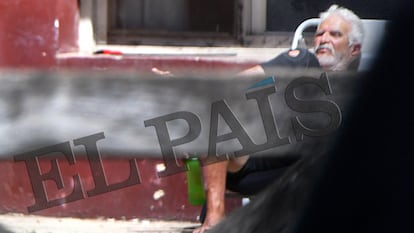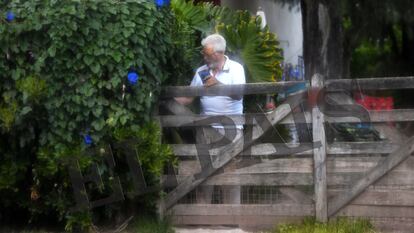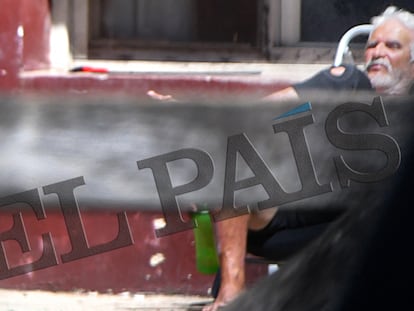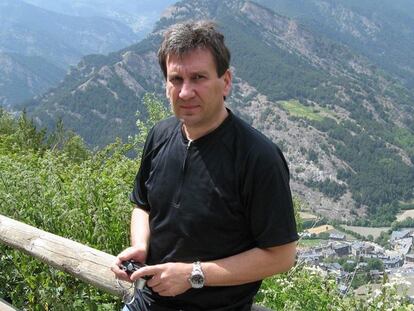The murderer of Arturo Ruiz maintains that he worked for the Civil Guard in the dirty war against ETA
Police databases have no record of José Ignacio Fernández Guaza, who claims that he was part of a ‘commando’ unit of 15 civilians that executed terrorists in the south of France in the mid-1970s

José Ignacio Fernández Guaza, the fugitive neo-fascist, has been located by EL PAÍS in Buenos Aires (Argentina) years after murdering 19-year-old student Arturo Ruiz and fleeing Spain in 1977. The 76-year-old’s past is intimately connected to the dirty war against ETA. The gunman told this newspaper that he was part of a commando unit that supposedly killed members of the terrorist group in the south of France in the mid-1970s. His group, according to what he said, was made up of 15 civilians who had military training, worked for the Spanish Civil Guard, and was paid from specially reserved funds.
Fernández Guaza maintains that his victims, whose identities he avoids revealing, belonged “to the uppermost echelons of the hierarchy” in the Basque terrorist organization. The summary of the case of Arturo Ruiz contains witness statements and suggestions that link this gunman with the Civil Guard and the dirty war against ETA.
The actions of the unit that the neo-fascist belonged to were developed — according to the fugitive — in collaboration with the French police. And they coincide in time with the bombing campaign and attacks by far-right groups against ETA after the group’s deadly attack against the late president of [Franco’s] Government, Luis Carrero Blanco in 1973.
“We crossed the border [between Spain and France] to look for information and also to catch some ETA members. […] I always got paid very well. I am very good at my job. […] They paid us in cash,” Fernández Guaza recalls.
According to the fugitive, the extreme-right militia, armed with Ingram submachine guns, stayed in safe houses for up to two months. The unit executed their victims at point-blank range.
“The General Directorate of Security knew what was happening. […] We had carte blanche. […] We approached and killed like them. There were no rifles with a telescopic sight. […] We also destroyed their economic apparatus. We blew up restaurants and businesses. We hit them where it hurt the most, the money,” he says.
The Civil Guard barracks in Gernika and Bilbao acted, the 76-year-old tells us, as the base of an organization that worked in coordination with the French secret services.
“Gernika, Bilbao, Lekeitio. They were our houses.”
The enigma of the DNI
The man who killed Arturo Ruiz has no national identity document (DNI) in the Spanish police databases, despite the fact that international search and arrest warrants were issued against him, and have already expired, as EL PAÍS has verified. A gesture for which the neo-fascist thanks his benefactors.
“They were people who cared about me. They told me: ‘Let’s make him disappear.’ I never existed,” he remarks.
A police source justifies that the murderer does not have a DNI in the context of the protective mantle that protected the extreme right-wing commandos who collaborated with the dirty war. “It is very serious and unusual. Four decades ago, before digitalization, it was easier to hide information. Only a small group of officials accessed the data,” adds an inspector from the Spanish National Police.
Fernández Guaza vanished from Spain in January 1977, after shooting high school student Arturo Ruiz twice. The youth was in the heart of Madrid taking part in a demonstration calling for an amnesty for political prisoners. It happened the day before the massacre of the Atocha labor lawyers. Four lawyers and a worker from a Madrid law firm linked to the Workers’ Commissions union and the Communist Party died in this far-right attack, which inaugurated a week in which fascist cells maneuvered to blow up democracy.
The murderer’s escape allowed him to avoid trial, a guaranteed conviction, and a prison sentence. He made the trip from Irún to Paris by car using a false passport given to him by the “Spanish security services,” according to Fernández Guaza, and he remained hidden for a year in a small apartment in the French capital.
“I left Paris because ETA was after me,” he says.
After leaving France, the fugitive lived in Buenos Aires for a year and, later, in Ingeniero Maschwitz, a town of 15,000 inhabitants 28 miles from the Argentine capital, where he bought a house in the name of one of his three children.
At almost 800 pages in length, the summary of the Arturo Ruiz case includes four testimonies that point to the neo-fascist’s relationship with the Civil Guard and the dirty war. His partner for seven years, C. Chacón, told the authorities in 1977 that it was common to see weapons in her house on López de Hoyos Street in Madrid because her boyfriend “worked for the Civil Guard and Police.” She added that the murderer was a member of an Olympic shooting club in Madrid and that he had an espingarda [a weapon similar to a rifle, but with a longer barrel], a pistol, and ammunition. And she explained that Fernández Guaza was “frequently” absent from the home without revealing his whereabouts. “On one occasion, he told me he was going north,” Chacón recalled.
The fugitive’s ex-girlfriend also stated that one day after the student’s murder, Fernández Guaza telephoned to ask her to send a money order of 15,000 pesetas ($96) to the civil guard at the Gernika J. García Cabrera barracks. The investigation never determined what the payment was for. The agent confirmed this information to the police and specified that he maintained a “relationship of trust” with the far-right gunman, whom he had met in 1975 at a mass in Bilbao in honor of a colleague who died in an attack.
M. R. Fernández, the fugitive’s sister, confessed to the police that she was guarding her brother’s suitcase with dozens of 9 millimeter Parabellum cartridges. This is ammunition used in most of the attacks perpetrated by the extreme right against ETA.
The neo-fascist J. Serrano Rodríguez de Verges testified to the authorities that he once traveled to Bilbao with Fernández Guaza, whom he had met at an event held by the far-right Fuerza Nueva party. He framed the journey as a mission to “neutralize the actions of ETA.”

The judicial investigation concluded with the conviction of Jorge Cesarsky, an Argentine linked to the Argentine Triple A terrorist group, who was sentenced to six years in prison for terrorism and the unlawful possession of firearms. He served only one year in prison for criminal possession of the murder weapon. Meanwhile, Fernández Guaza, who never stood trial, has lived with impunity for 46 years.
The fugitive says he was friends with Juan Antonio González Pacheco, also known as “Billy the Kid.” The police officer in the Social Political Brigade, who died of Covid in 2020, was accused of torture by dozens of those whom the dictatorship retaliated against.
According to what a mercenary from the GAL (Anti-Terrorist Liberation Groups), the quasi-police organization that murdered 27 ETA members between 1983 and 1987, told this newspaper, the majority of far-right commandos linked to the dirty war maintained “strong ties” with the Social Political Brigade and the Civil Guard.
Revenge is the argument that Fernández Guaza uses to justify doing the dirty work for the state.
“My father was a soldier and a good friend of [Luis] Carrero Blanco. What was the fault of the driver of the late president of the government who died in the attack? You were not there when they planted the bomb on Correo Street in Madrid [ETA attack in 1974 that caused 12 deaths and 71 injuries, which was considered the gang’s first mass killing of civilians]. It is within human law. An eye for an eye, a tooth for a tooth. It’s very hard when a mother comes to you at a funeral and says: why did they kill my son?” Fernández Guaza says.
The gunman does not regret Ruiz’s murder and boasts of keeping evidence of this delicate story safe.
“I’m 76 years old, but I have a head like a CPU,” he says.
After the death of Francisco Franco in 1975, far-right terrorism operated under different acronyms. The Spanish Basque Battalion (BVE), the Anticommunist Apostolic Alliance (Triple A), and the Spanish Armed Groups (GAE) were its most active organizations. In order to short-circuit the Transition and respond to ETA, the quasi-police militias perpetrated 60 murders between 1975 and 1982, according to the study Terrorism in Spain (Ministry of the Interior).
investigacion@elpais.es
Sign up for our weekly newsletter to get more English-language news coverage from EL PAÍS USA Edition
Tu suscripción se está usando en otro dispositivo
¿Quieres añadir otro usuario a tu suscripción?
Si continúas leyendo en este dispositivo, no se podrá leer en el otro.
FlechaTu suscripción se está usando en otro dispositivo y solo puedes acceder a EL PAÍS desde un dispositivo a la vez.
Si quieres compartir tu cuenta, cambia tu suscripción a la modalidad Premium, así podrás añadir otro usuario. Cada uno accederá con su propia cuenta de email, lo que os permitirá personalizar vuestra experiencia en EL PAÍS.
¿Tienes una suscripción de empresa? Accede aquí para contratar más cuentas.
En el caso de no saber quién está usando tu cuenta, te recomendamos cambiar tu contraseña aquí.
Si decides continuar compartiendo tu cuenta, este mensaje se mostrará en tu dispositivo y en el de la otra persona que está usando tu cuenta de forma indefinida, afectando a tu experiencia de lectura. Puedes consultar aquí los términos y condiciones de la suscripción digital.
More information
Archived In
Últimas noticias
Welcome to the post-religion era: The idea of Christianity as the absolute truth has become obsolete
‘I thought you would like it’: The risky sexual practice popularized by TV shows and TikTok
The digitalization of tourism: ‘They promise experiences and gave us the worst possible one’
Mexican peso defies uncertainty with forecasts of a new period of stability in 2026
Most viewed
- Sinaloa Cartel war is taking its toll on Los Chapitos
- Reinhard Genzel, Nobel laureate in physics: ‘One-minute videos will never give you the truth’
- Oona Chaplin: ‘I told James Cameron that I was living in a treehouse and starting a permaculture project with a friend’
- Why the price of coffee has skyrocketed: from Brazilian plantations to specialty coffee houses
- Silver prices are going crazy: This is what’s fueling the rally










































